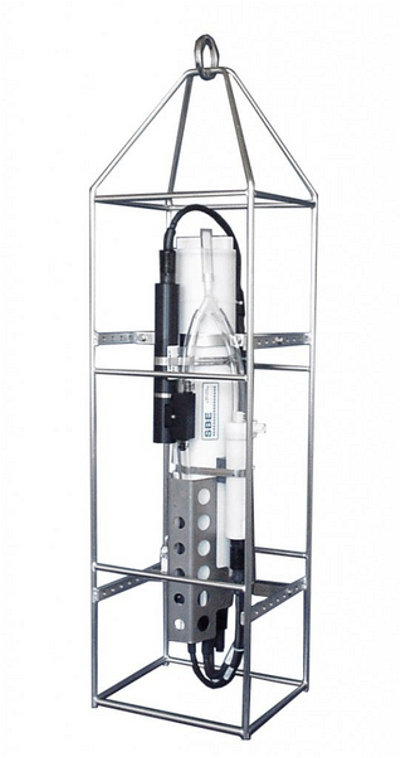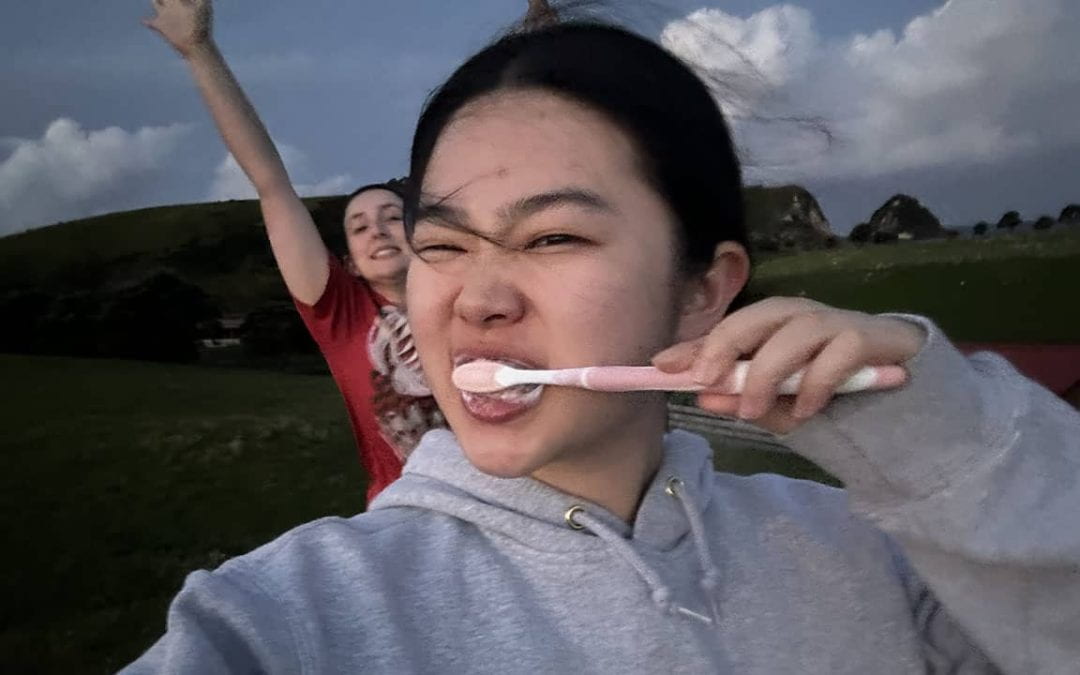Image: Rachel Liu (front) and Anya Christiansen undertook archaeological field work on Ahuahu Great Mercury Island as part of their summer internship.
2 March 2023
It’s lucky that Jed Thompson-Fawcett’s summer internship supervisor didn’t tell him how much the equipment he was working was worth before she let him do an experiment with it.
Jed (Ngāti Whātua) was one of 13 interns supported by Te Pūnaha Matatini over the 2022-23 summer, on projects ranging from natural language processing of te reo Māori and philopatry of seabirds through to defense behaviour of wētā and obsidian hydration dating.

The SBE 19plus V2 SeaCAT is delicate and expensive.
Jed was working with Te Pūnaha Matatini Principal Investigator Inga Smith to compare measurements between two conductivity, temperature and depth (CTD) instruments in supercooled water. These measurements are important for our understanding of sea ice, which influences the global climate.
The majority of Jed’s work was analysing data collected on the instruments by Inga and a small team in McMurdo sound, but she also let him have a go on one of the CTDs.
The SBE 19plus V2 SeaCAT has a glass conductivity cell with electrodes throughout it. It’s delicate and expensive. “I’m very glad that Inga didn’t tell me how much it cost,” says Jed. “I wouldn’t have done the experiment if I knew!”
Rachel Liu and Anya Christiansen used more robust equipment for their archaeological field work on Ahuahu Great Mercury Island, working with Te Pūnaha Matatini PhD student Alex Queenin. They got a lot of hands-on experience with vibracoring and surveying. And although they had to haul the surveying equipment up and down a steep hill about 50 times, they both enjoyed the experience.
Alana Rodrigues-Birch also spent the summer on an archaeological internship, but “instead of being out in the field and having lots of nice times dragging stuff around up and down hills, I was in a lab.”
Alana used obsidian hydration dating to investigate when obsidian artifacts found on Tūhua Mayor Island were made. This was to help to create schematics showing trade networks between different groups of Māori.
“I realised I actually really like being locked in a lab all summer,” says Alana. “Archaeology is often represented as being a very field-heavy discipline, but this experience showed me how the lab work is important as well.”
Te Pūnaha Matatini has a longstanding relationship with Te Hiku Media, and Alice Qin was under their wing as an intern this summer. She spent her time identifying misalignments in te reo Māori in Te Hiku’s natural language processing model Papa Reo. Alice is completing postgraduate study in statistics, specialising in machine learning, so this internship was a perfect fit for her.
As part of their internship, Luke Thompson and Hamish Doogan had the exciting opportunity to contribute to a research article on defensive behaviours in wētā that they plan to submit for a special issue of the New Zealand Journal of Zoology.
Toni Gordon produced a two-minute mixed-media video to help rangatahi understand eDNA, which will be hosted on the Science Learning Hub website under her creative name Iona Rachilde, and Brittany Bennenbroek will be publishing a visual timeline of policy events in Aotearoa New Zealand relevant to the Kindness in Science approach.
Te Pūnaha Matatini Deputy Director Mike O’Sullivan took charge of the internships this summer, and looked after the interns. They started with an induction, followed by two catch-ups and a concluding hui for everyone to share their mahi.
Ela Hunt worked on philopatry in seabirds, and said that she appreciated the chance to hear about the other projects and how everyone was doing. “Sometimes you can feel a little alone, or not know if your project is going the way it should be going,” she says. “It was a great opportunity to follow along and see how other people doing a similar kind of internship are finding things.”
Te Pūnaha Matatini Director Cilla Wehi loved the diversity of topics among our summer interns. “It reminds me of what we do at Te Pūnaha Matatini,” she says. “A bunch of mathematicians and physicists and computer scientists sitting in a room with historians and ecologists and science communicators.”
“This strange interdisciplinary space is where the best ideas come out, and it turns out it’s really important when we’re trying to solve these big problems like biodiversity loss, climate change, or thinking about health and how we can work to improve the lives of people in our society.”
“Our interns brought themselves to the work and made the projects interesting. They’ve all done an amazing job in such different ways, whether it’s sticking their hands into ice cold water, trying to draw eels peeing, grappling with the difficulties of how to define different terms, finding animals when it’s difficult, doing fieldwork or grappling with mathematical equations.”
“Their work is going to provide a great springboard for students in years to come.”
Te Pūnaha Matatini summer interns 2022-23
- Brittany Bennenbroek | Past policy changes and kindness in science | Office of the Prime Minister’s Chief Science Advisor / Kindness in Science
- Toni Gordon | Communicating eDNA | Cawthron Institute
- Alice Qin | Misalignments identification for te reo Māori | Te Hiku Media
- Sophie Doyle | Community attitudes and awareness toward pekapeka | Department of Conservation / University of Waikato
- Hamish Doogan | Defensive behaviours of wētā | University of Otago
- Luke Thompson | Defensive behaviours of wētā | University of Otago
- Anya Christiansen | Vibracoring, surveying and core analysis | University of Auckland
- Rachel Liu | Vibracoring, surveying and core analysis horticulture | University of Auckland
- Anne Matena | Modelling healthcare delivery | University of Auckland
- Alana Rodrigues-Birch | Obsidian hydration dating | University of Auckland
- Jed Thompson-Fawcett | Comparing measurements taken in supercooled water | University of Otago
- Ela Hunt | Philopatry and seabirds | University of Otago
- Daniel Reid | Better AI | University of Auckland

